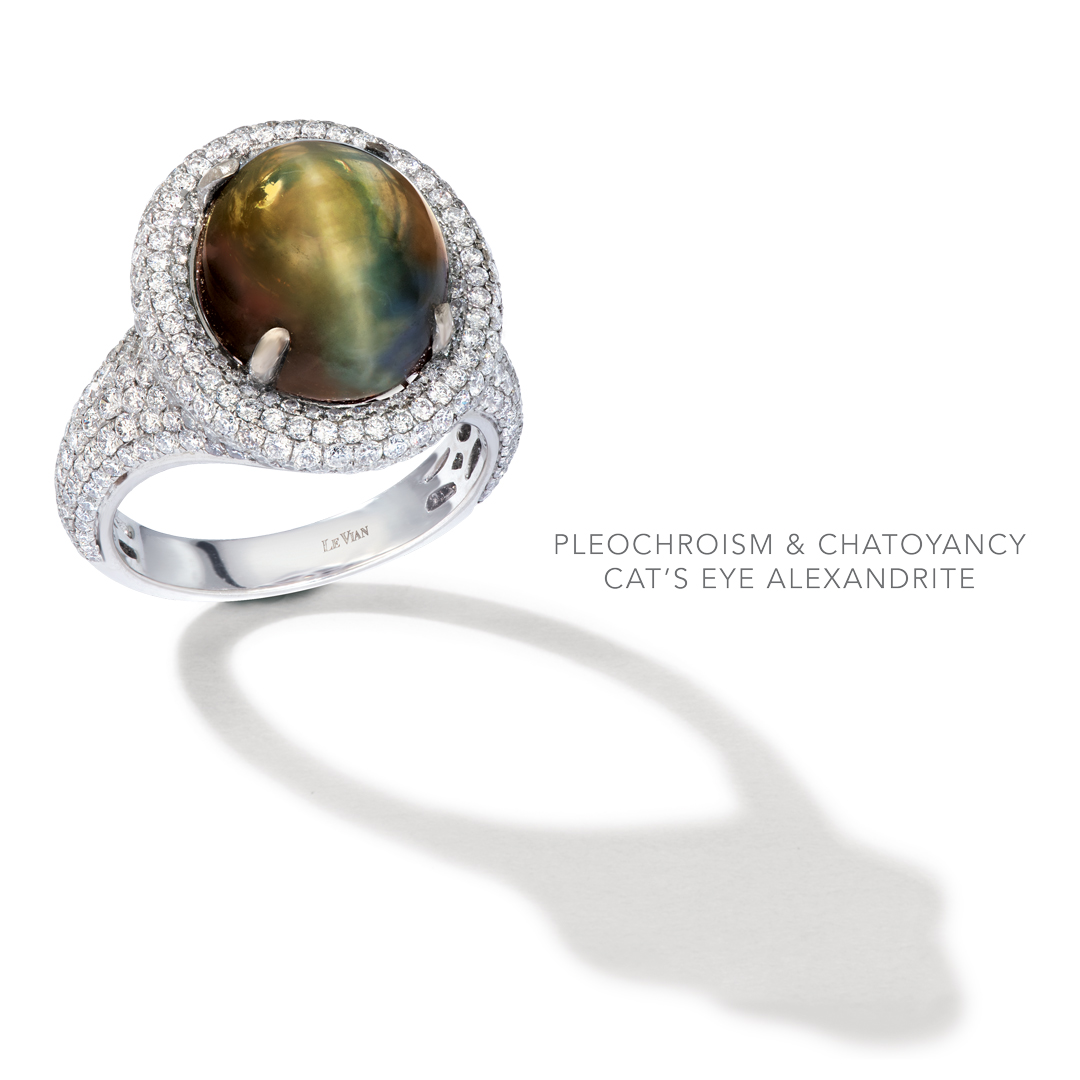The Phenomena Gem, Alexandrite
Hello June! Join us in welcoming the beautiful and very exciting gemstone Alexandrite, a Phenomena Gem, one of the three birthstones for June and the gemstone to celebrate the 55th wedding anniversary!
Alexandrite is among the most rare and highly valued stones in the gem world. It can exhibit 2 different phenomena, either together, or independent of one another: color change and chatoyancy. Its most important characteristic is the ability to change color when exposed to different light sources. In incandescent light it appears reddish while in fluorescent light it appears greenish.
Alexandrite is a member of the Chrysoberyl mineral family which also includes:
- Yellow Chrysoberyls (yellow to greenish yellow to green)
- Colorchange Chrysoberyls
- Cat’s eye Chrysoberyls
- Color change Cat’s eye Chrysoberyls (transluscent to opaque)
Some inclusions must be accepted with this stone unlike some of the other stones.

The Lore of Alexandrite
The story of Alexandrite is quite interesting and some say controversial. It all began in the 1830s, in the Ural Mountains of Russia. The legend says that a miner gathered these green stones from the emerald mine and brought them back to the campsite at the end of the day. But something strange happened upon showing them in the light of the campfire. The stones turned a brilliant red! When morning came, the stones were green. It was then that they realized that they found a new and mysterious gem! The new gem was named after Alexander II and caught the country’s eye because its red and green color mirrored the national military colors of Imperial Russia.
Where are Alexandrites Mined?
While Alexandrite was first discovered in the Ural mountain, the deposits didn’t last forever. Today, most alexandrites are not from Russia. You can still, however, find estate jewelry with the famed Russian Alexandrite, which remains “the quality standard” for this phenomenal stone. Most larger Alexandrites can be found in antique Russian pieces from the Victorian era.
While Alexandrite became popular in St Petersburg and Paris, it was New York’s George Kunz, the gemologist from Tiffany’s, who did the most to popularize this gem. He fell in love with this exciting gem and traveled to Russia in search of it. Tiffany then had reserves so large that it cornered the market for decades.
Fine Alexandrites are considered extremely rare (now more rare than diamonds!). Fine quality stones are practically unaffordable to the general public. Sourcing Alexandrite is very difficult and we shouldn’t expect to see them in the same sizes as we do with other stones. A one carat stone is already considered a large stone. As for shape and size, it depends on what becomes available in the market. Even lower quality stones are expensive and in limited supply.
Primary sources for Alexandrite include: Brazil whose gems are the most sought after and has experienced major price increases over the last three years. Brazil with many of the stones having very good saturation and a very good change of color, however most of the crystals that were found have been very small in size; Africa (which includes Tanzania, Sri Lanka and Madagascar) which have produced some very nice stones in larger sizes with the colors being more intense with common overtones of yellow and brown; and India where most of the stones display lighter tones with possible overtones of yellow or gray.
Gemological Properties of Alexandrite
Often described by gem-aficionados as ‘emerald by day, ruby by night’, Alexandrite is the phenomenal variety of chrysoberyl which forms in the orthorhombic crystal system. Alexandrite can only form when aluminum and beryllium combine with trace elements such as iron, titanium, and most importantly, chromium, which produces its beautiful color.
In addition to its famed color change, Alexandrite is also a strongly-pleochroic gem, which means it can show different colors when viewed from different directions. It is one of the few rare gemstones that is trichroic, including the colors green, orange, and purple-red.
It should be noted that the striking color-change phenomena in Alexandrite is not caused by the gem’s pleochroism, but from the mineral’s unusual light-absorbing properties.
Alexandrite displays either Red, Pink, or Purple or any combination of these colors, in different intensities, under incandescent light. Stones that possess a color change but display colors other than the ones mentioned above, or stones that display only one of the colors mentioned but not the other, are not considered Alexandrites and should be called “Color-change Chrysoberyl”. Buyer Beware: There are many stones out there that are called Alexandrites but should not be. You may find stones that display browns, oranges, yellows or grays as their predominant color. All stones should carry a certificate from a reputable lab.
Wear and Care:
Alexandrite, with a Mohs hardness rating of 8.5 and a toughness rating of “Excellent” figures to be a surprisingly durable gemstone. Alexandrites are one of the few stones for which GIA has no recommended disclosures. One of the reasons for its toughness is an absence of cleavage in its crystal structure. One should, however, take into account that it is not unusual for stones to contain internal inclusions. Though breakage during ordinary wear is unlikely, as with all jewelry, care to protect the stone from sharp blows should be taken, especially because of the rarity and cost of alexandrites. Their scarcity would make a replacement both costly and difficult.
Alexandrite can be cared for by cleaning with alcohol and a soft toothbrush.

